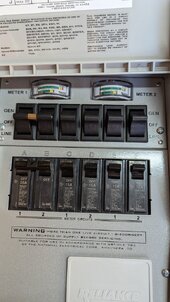k490
Solar Enthusiast
This is a design I came up with I have purchased one inverter to get 120V 3000 Watts of inverter output and 4680 watts of solar this year I want to wire everything for a future 2nd inverter next year. What I want to do is set this up in a shed using DIY battery Bank. I have an electronics background I have a technical certificate and worked for several years repairing power supplies and CRT monitors until I headed into IT world in the late 1990's. I have done some electrical work I have a decent understanding of house wiring 120V and split phase 240V.
The question I have is can I continue to use the N&G bond inside the service entrance of my house EG-4 disabled the software and removed the screw inside this inverter which use to have a relay switched the bond from input wiring to bonding inside the inverter. I have verified with a meter that the N&G inside the inverter is not connected which is what I want.
Will there be any issues with powering the EG-4 grid input and sharing the neutral with everything?
The question I have is can I continue to use the N&G bond inside the service entrance of my house EG-4 disabled the software and removed the screw inside this inverter which use to have a relay switched the bond from input wiring to bonding inside the inverter. I have verified with a meter that the N&G inside the inverter is not connected which is what I want.
Will there be any issues with powering the EG-4 grid input and sharing the neutral with everything?
Attachments
Last edited:






